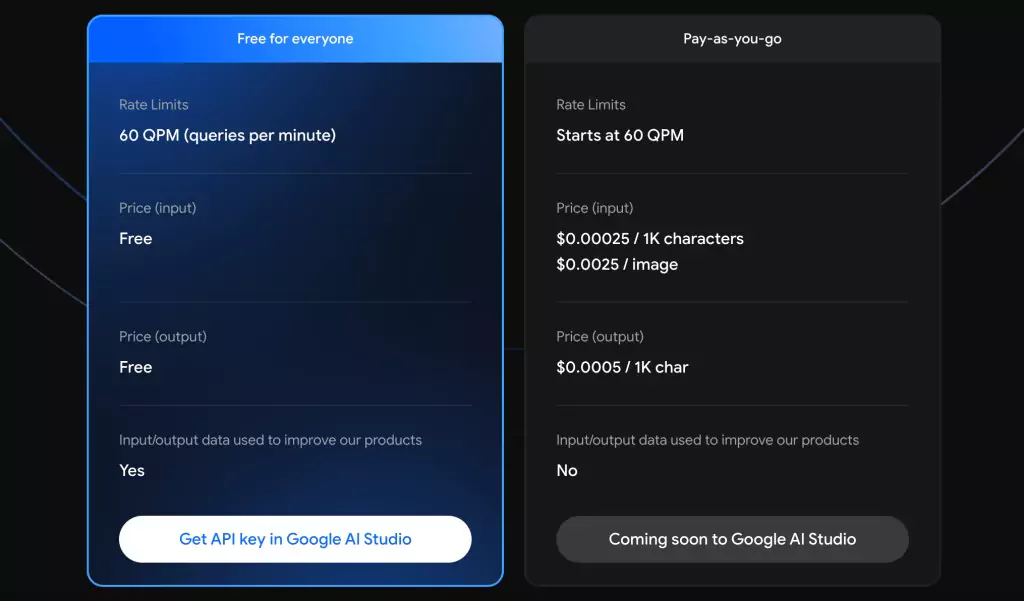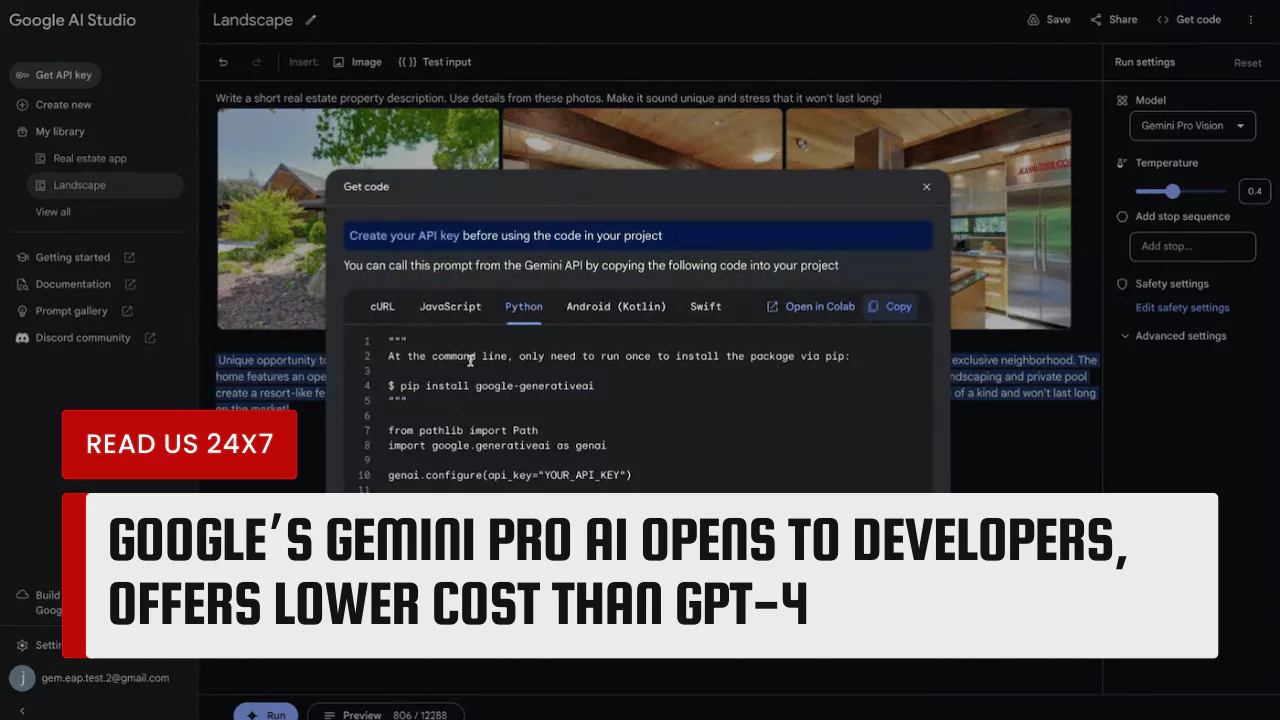Google has recently announced the launch of its new artificial intelligence model, Gemini Pro, which is open to developers and offers a lower cost than the rival GPT-4 model. Gemini Pro is a multimodal AI that can handle text, images, audio, and video, and can learn from real-time feedback. Gemini Pro aims to compete with GPT-4, the latest version of OpenAI’s powerful language model, which is expected to be released later this year.
In this article, we will explore the features, benefits, and challenges of Google’s Gemini Pro AI, and how developers can access and try it.
How Does Gemini Compare to GPT-4?
Comparing Gemini and GPT-4, both cutting-edge large language models reveal strengths and weaknesses in each. Here’s a breakdown:
Strengths of Gemini
- Computing power: Gemini boasts 16,384 TPUv5 chips, more than five times GPT-4’s capacity. This translates to faster processing and potentially better performance on demanding tasks.
- Multimodality: Gemini handles text, images, and videos, while GPT-4 primarily focuses on text. This multimodality opens doors for tasks like video captioning, image generation, and visual reasoning.
- Performance: On certain benchmarks, Gemini outperforms GPT-4, particularly in tasks involving mathematical reasoning and visual contexts.
Strengths of GPT-4
- Safety and Alignment: OpenAI prioritizes safety and alignment with human values in GPT-4, minimizing bias and harmful outputs. This focus makes it potentially more reliable for sensitive applications.
- Creative Problem-solving: GPT-4 demonstrates strong creative abilities, generating original content like poems, code, and scripts. Its focus on reasoning aids in solving novel problems.
- Accessibility: GPT-4 is more readily available through OpenAI’s API, while Gemini remains largely under development and in limited access.
Other Factors to Consider
- Transparency: GPT-4 has a more open development process, leading to greater transparency and community discussion. Gemini’s development is more guarded, which can raise concerns about bias and control.
- Specific applications: The choice between Gemini and GPT-4 depends on the task at hand. If raw processing power and multimodality are crucial, Gemini might be better. If safety, creative problem-solving, and accessibility are priorities, GPT-4 might be the preferred choice.
Ultimately, both Gemini and GPT-4 represent significant advancements in AI technology. As they continue to evolve, both models hold immense potential to revolutionize various fields.
Benefits of Google’s Gemini AI
Google’s Gemini AI offers several benefits for developers and users who want to leverage the power and potential of artificial intelligence. Some of the benefits are:
Lower Cost

Gemini Pro presents users with two pricing plans: a free tier with a limitation of 60 queries per minute (QPM) and a pay-as-you-go option that starts at 60 QPM. Beyond the free tier threshold, Google applies an input fee of $0.00025 per 1,000 characters or $0.0025 per image and an output fee of $0.0005 per 1,000 characters. This pricing model positions Gemini Pro as a more cost-effective solution compared to GPT-4.
In contrast, OpenAI, the creator of GPT models, utilizes a token-based pricing system. OpenAI charges $0.03 per 1,000 tokens for input and $0.06 per 1,000 tokens for output. Given OpenAI’s token definition (one token approximately equals four characters), Gemini Pro’s pricing can be translated to approximately $0.001 per 1,000 tokens for inputs and $0.002 per 1,000 tokens for outputs. The comparison in the table below reveals that Gemini Pro is priced competitively, especially when considering GPT-3 Turbo.
Enhanced Performance
Google has claimed that Gemini will have a higher performance and accuracy than GPT-4, which may make it more reliable and useful for developers and users who want to use it for their tasks and goals. Google has also said that Gemini will have a faster and smoother processing speed than GPT-4, which may make it more efficient and user-friendly for developers and users who want to use it for their interactions and outputs.
Potential for Advancements in Scientific Research
Google has stated that Gemini will have the potential to contribute to the advancements in scientific research and discovery, as it can handle and generate complex and diverse data and content across different domains and modalities. Google has also said that Gemini will have the potential to collaborate and cooperate with other AI models and systems, such as Google’s own TensorFlow and Cloud AI platforms, which may make it more powerful and versatile for developers and users who want to use it for their experiments and innovations.
How to Access and Try Google’s Gemini AI?
Google has said that Gemini will be open to developers and users who want to access and try it for their purposes and applications. Google has also provided some information and instructions on how to access and try Gemini. Some of the steps are:
Sign Up Process
Developers and users who want to access and try Gemini will have to sign up for a Google account if they do not already have one, and register for the Gemini Pro AI program, which will require them to provide some basic information and agree to some terms and conditions. Developers and users who sign up for the Gemini Pro AI program will also have to pay a fee, which will depend on the type and amount of usage they plan to have.
Available Features
Developers and users who access and try Gemini will have access to a range of features and functions that Gemini can offer, such as text, image, audio, and video generation and understanding, real-time learning and personalization, multimodal input and output, and various tasks and domains. Developers and users who access and try Gemini will also have access to a dashboard and a console, where they can monitor and control their usage and outputs, and provide feedback and suggestions to Google.
Comparison With Other Google AI Models
Developers and users who access and try Gemini will also have the opportunity to compare and contrast Gemini with other Google AI models and systems, such as Google’s BERT, Meena, and Duplex, which are also available for developers and users to access and try. Developers and users who access and try Gemini will also have the opportunity to compare and contrast Gemini with other non-Google AI models and systems, such as GPT-4, which are also available for developers and users to access and try.



